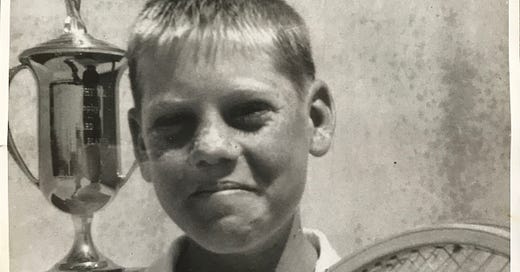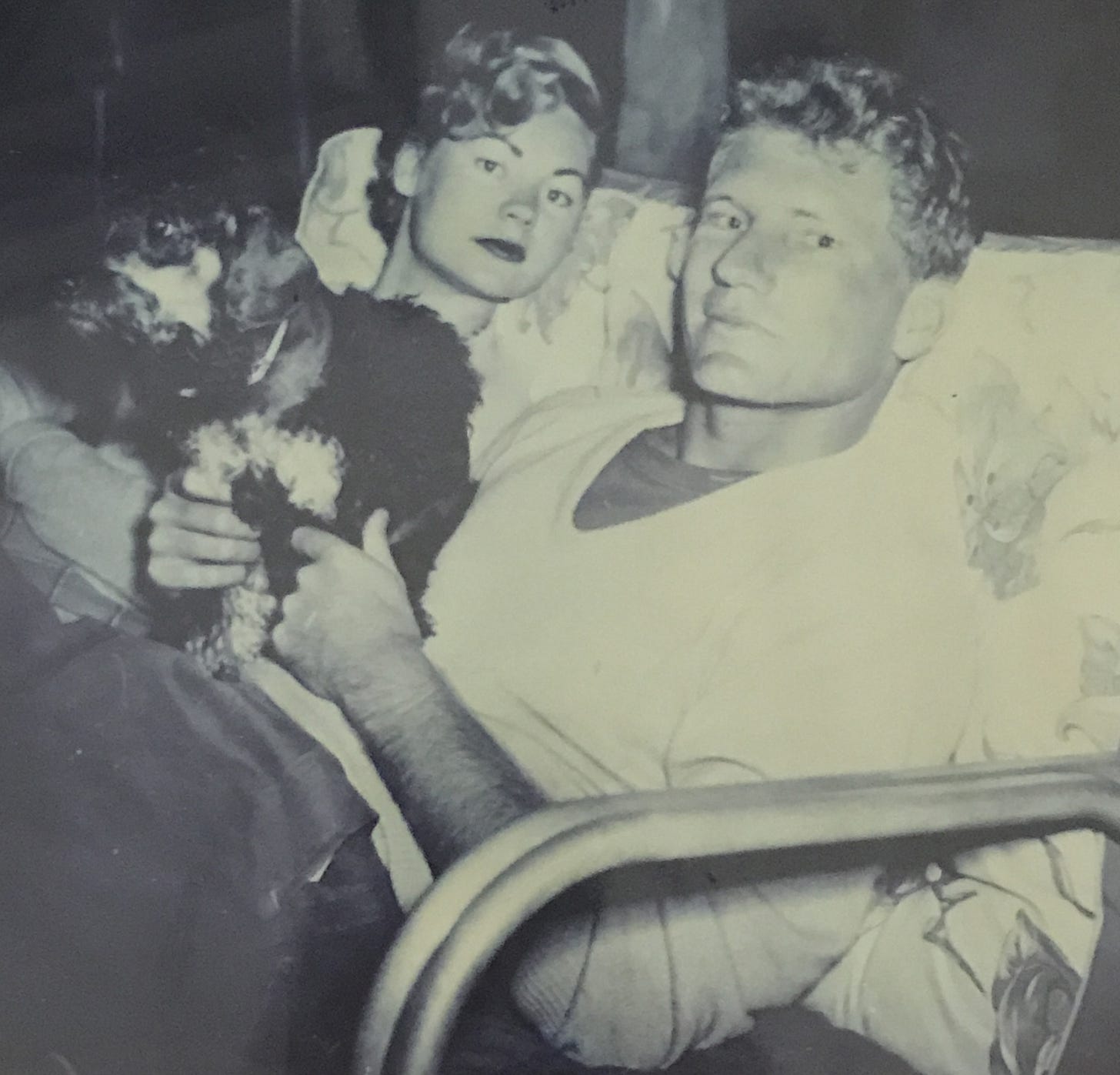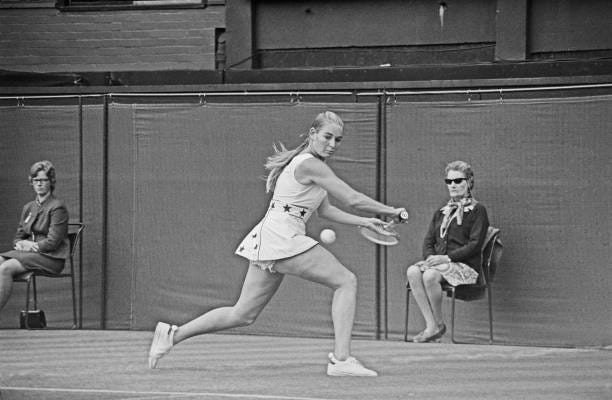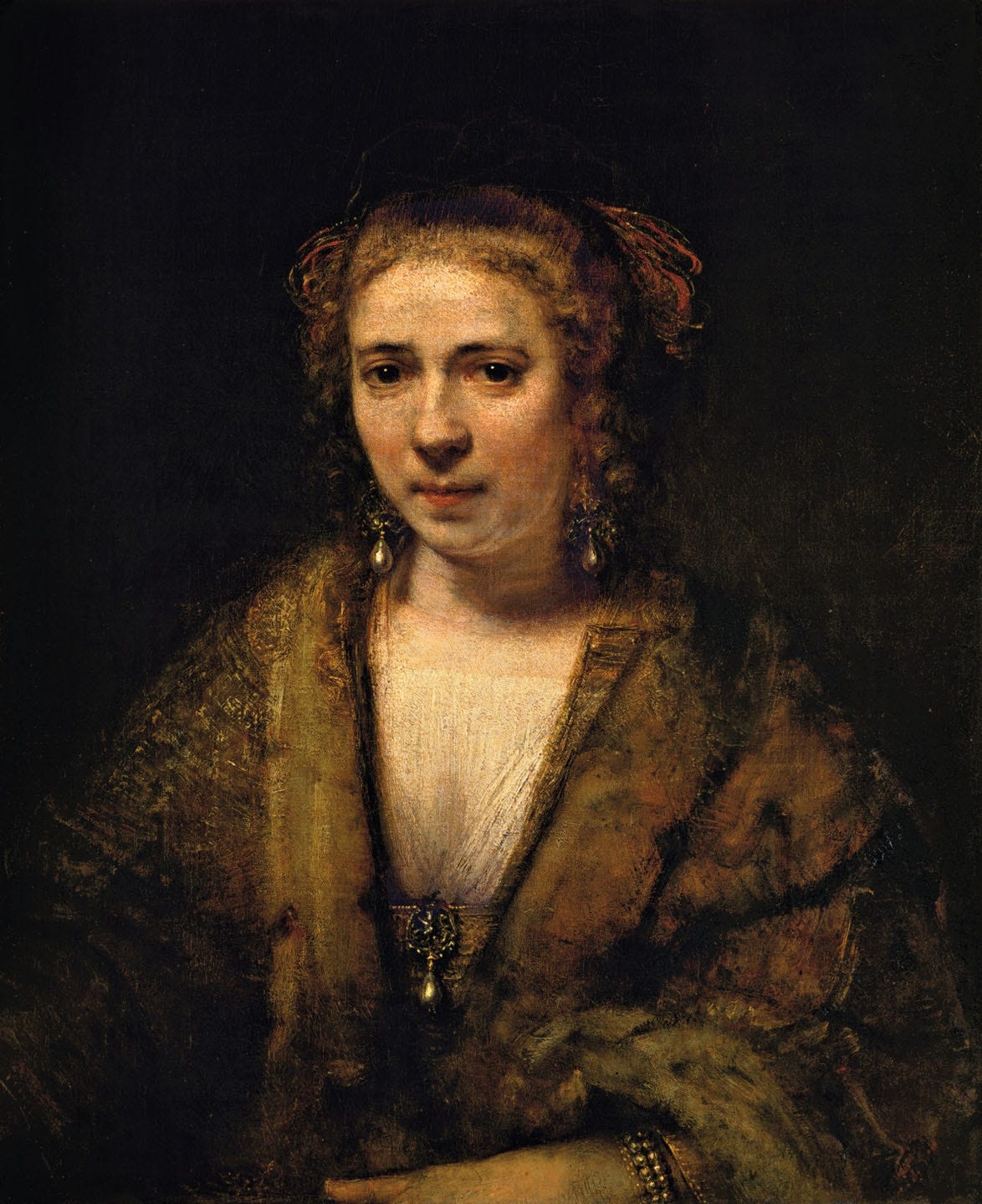Note: This is the start of my art memoir manuscript.
I looked up, and everything was shimmering, fractured glints of light. Cutting through the glare was a beige silhouette of a man, like Superman, flying across the sky, framed by the sun. Then there was a huge splash of aqua-tinted water that smelled of chlorine.
This is my first memory. The man was my dad, and he had dived into the golf club’s pool fully clothed, including his leather golf shoes, to rescue me from drowning. I was three years old, and I had just walked over the ledge into the pool. My mom was there, only a few feet away, in a lounge chair reading a book. Apparently, everything happened in the blink of an eye.
1 Ann and Paul Newberry, my young parents. Circa 1951.
I was born in the beautiful ocean town of La Jolla, California. La Jolla is often translated as the jewel from the Spanish la joya, and it is indeed a jewel. As one of the richest and most beautiful towns on the California coast, it rivals any of the sparkling gems on the French and Italian Rivieras. My birth took place in the hospital that overlooked an intimate and tiny cove on the Pacific Ocean. That hospital was later torn down and replaced by the Contemporary Museum of Art San Diego. Hopefully, that is a prophetic sign that one day I will have a show there.
As kids, my four siblings and I didn’t spend much time at home; rather, we spent all our free time at the La Jolla Beach and Tennis Club. It had twelve immaculate tennis courts, with a main court surrounded by shaded, forest-green-colored stands about four rows deep. Adjacent to the courts was a formal garden featuring a water fountain adorned with large turquoise-patinated bronze sea horses and beautiful blue and rust-colored tiles. Beyond the garden stood a pale ochre yellow two-story building housing suites for tourists, such as the rich Texans who would spend their summers there. A wide corridor, cutting straight through the building, opened onto the gray-green Pacific Ocean, cerulean sky, and the Beach Club’s private, sandy beach. Approaching the corridor was always a thrill, with a blast of wind funneling through from the beach. In the summers, we literally ate every night at the beach, sitting in the sand around a fire pit. I remember my mom’s spaghetti and meat sauce, which she had prepared at home and heated up there.
I started to play tennis at nine years old, and perhaps my first and greatest mentor was Lester Stoefen, a three-time world champion doubles player. He was very tall, standing at 6 foot 6, and Hollywood handsome. During a half-hour lesson, he would say very little, but the simple suggestions he made had a huge impact on improving my shots. These suggestions worked excellently under the pressure of competition, as evidenced by my first championship win: Escondido Boy’s Ten and Under.
2 Michael Newberry, 1965. Escondido, California.
3 Lester Stoefen, 1936. Wikimedia.
My older sister, Janet, and I, would play tennis everyday at the club from when school got out till dark. Sometimes we played together but mostly against our peer group. On weekends and in the summers, we played from morning to night. The club always had a handful of kids that had won national championships. My sister being one of them. Though it was fun, it was pretty serious. For instance, when I was fifteen, and Janet was eighteen, we won the 1972 Southern California [Adult] Mixed Doubles Championship at the Los Angeles Tennis Club on their marvelous center court. An unheard-of victory, considering I was still not physically mature, and our opponent's male half was a member of the NCAA national powerhouse UCLA tennis team. Through, Janet, in the next year, would go on to reach the mixed doubles finals of Wimbledon playing with the great Raul Ramirez losing to legendary Billie Jean King and Owen Davidson. It is very likely that our mixed doubles win had a lot to do with the fact that my sister was one of the best tennis players in the world.
4 Janet Newberry, Wimbledon 1972, Tennis Pro Legacy on Facebook.
Eleven Years Old
Without question, I was born with a silver spoon, but that doesn’t fully explain why I would become such a lifelong, dedicated, and passionate artist. Aside from being mentored by Stoefen, there were four other early events—occurring when I was eleven—that would significantly shape my artistic future and prepare me for the marvelous celebration of Aristotle’s concept of eudaemonia.[1]
Rod Laver
Arguably the greatest tennis player of all time, two-time Grand Slam Champion Rod Laver, was playing in the National Men’s 35 and Over Championship at the Beach Club. I was standing next to him near the empty front court, where he was scheduled to play a match in fifteen minutes. Even though I knew he was great, it didn't occur to me not to ask him to hit. He said “Yes,” and I got to rally with him for the next fifteen minutes. It must have amused him, but he would have related to a young kid's enthusiasm.
My First Traffic Ticket
In the winter months, late in the afternoon, my dad would play poker with a few of his buds at the club’s cardroom. I knew he would play for a couple of hours and then head home for dinner. My siblings would simply walk the few blocks home when it got dark. I, on the other hand, was fascinated by driving. I would wait until the club was empty except for the men inside the card room, then I would go into the parking lot and get in the front seat of my dad’s 1967 banana-yellow Chevrolet Impala.
With a feeling of guilty excitement, I would leave the car in park, put my foot on the brake, turn the key in the ignition, and feel a rush of excitement. Then, I would turn it off and surreptitiously look around to see if anyone had noticed. Next, I would put the transmission in drive and then in reverse, moving the car a few feet in either direction. Finally, I drove the car around the circular 1,000 ft route of the club’s entrance. It was such a rush! I was really driving.
It was the era when everyone left their front doors open and their keys in the ignition. I also continued my experiments in the driveway at home around 2 o’clock in the morning. In all that time, I never saw my parents’ bedroom lights flick on. To me, of course, this meant I had a continuing green light.
On the fateful night, I got up at 2 or 3 a.m. and backed the car out of our long driveway to the street. So far, everything had gone perfectly. I had made no technical mistakes, and my parents were oblivious to my secret excursions. Idling in our quiet street, I decided then to drive to town. I was about to embark on one of the most exciting experiences of my life! We lived in the Shores, and the town of La Jolla was about a mile and a half away. It was time to be off and running! And off I went.
I was driving on Prospect near the Cove and passed a parked cop car on the other side of the street. I continued on, but when I cautiously looked in the rear-view mirror, I saw the police car make a U-turn and begin to follow me. I simply continued to drive for some minutes, and then… they turned on the red light. I didn’t know what that meant, but I knew it couldn’t be good. I vividly remember how the red light seemed to set the car interior ablaze.
The roads in La Jolla are small single lanes that wind around. With the cops following, I continued to drive towards Bird Rock, the next town. Now I was about 4 miles from home. Finally, when the road widened, the cops pulled alongside me and flashed a searchlight in my face. I distinctly heard one cop say, 'Oh my god, it is a kid!' They gestured for me to pull over, and I complied
After parking the car, they placed me in the back seat of the police car and proceeded to drive me home. They asked me some questions, which I don’t remember, but about halfway home, I asked them why they pulled me over. I was curious, and I didn’t want to make that mistake again. I saw the profile of the cop’s face in the passenger seat, and he had a look of 'Do we tell this kid what he did wrong, or not?!' He was clearly anticipating that my motive for the question was to improve my driving.
They did tell me and explained that I had the high beams on, and since I never turned them off, they thought I might be a drunk. I didn’t know what the high beams were, so I asked for clarification, and I received a lesson from them about car operations. I also felt strangely calm. I had heard stories of 15-year-olds getting caught driving and having their future licenses suspended for six months. But I knew with certainty that an 11-year-old was too young to be penalized like that.
When you're the parents of five kids, I guess it’s hard to be shocked at being awakened at 4 a.m. by one of those kids explaining that two policemen are waiting at the front door to talk to you. My parents were too sleepy to register it, and I was free to go to my room and go to sleep, happily content.
The next day, Mom thought the episode was hilarious, but my dad, the lawyer, tried to explain to me that if I had had an accident, my family could have been sued for everything. His comment was over my head at the time, and it certainly did not diminish the excitement of experiencing the greatest adventure of my lifetime, so far. And I knew I wanted more of them.
Childhood Angst
There was something wrong. I was having a moral crisis, and I was only eleven years old. The problem was, I had no idea what was causing my mental upheaval. It was physically painful, thinking so hard. And the toughest part was, I didn't understand the cause, and I desperately wanted to.
In a big family, there aren't many places to be alone, but our house had four bathrooms, so locking oneself in the bathroom isn't holding anyone back from using another one. With an abundance of quiet, time, and privacy, I locked the door, stretched out on the floor, and started to think. I was feeling a pressure so painful that I desperately tried to push it out of my brain by pressing my hands against my skull. I knew something was wrong, but was it me? Was I somehow evil? (Apparently, kids can easily take on unearned guilt and believe the only solution is suicide.)
I began to analyze my thoughts, feelings, events, experiences, and other people. I was on a mission to discover where exactly this horrible feeling was coming from. I must have spent two or three hours going over my experiences and asking questions like: Did I do anything bad? Did I hurt someone? Was I deserving of care, of being loved? I could not find any cases where I willfully tried to hurt someone or tried to get away with a lie; and I was never a bully, other than teasing my siblings. If the bad was in me, I wanted to know, so I could do something to correct it. Towards the end of the exhausting event, I came to the conclusion that deep down I was a good person, and the bad feelings must be coming from something or someone outside of myself.
Awakening
It was midday in summer, and I was walking with my dear grandmother, Edna, on La Jolla’s main street, Girard Avenue. It had quaint, one and two-story shops painted in soft, pastel colors. We stopped at the Warwick bookstore's front window, and I was held there, fascinated by the portrait painting of a woman on the cover of a very large book. I was captivated by the cool, golden light that flowed over the portrait's face and chest. I literally forgot where I was. I forgot my grandmother's presence. Time froze as I continued in slow motion to follow the painting’s light.
The paint moved through the deep recesses in the shadows, up and around the woman’s forehead and nose, and ended as glints in her empathetic eyes. It was as if she was really alive and seeing right through me. She had the most sensitive and intelligent expression of understanding. I felt an overwhelming emotion of transcendence. It was exponentially much more powerful than the excitement of driving, and it was soul-shattering. More precisely, it was shattering my old self and awakening some kind of tremendous potential within me.
I remember returning to the world as if from a dream and wondering where I was. I looked for my grandmother. She was about 10 feet away from me with her body facing the store window, and her gaze was an indescribable expression of wonder that was transfixed on me. Nonchalantly, she silently conveyed I could continue looking at the book because there was something she wanted to look at in her window. When I returned to looking at the portrait, the emotion continued to grow and expand—a feeling of enormous love that was much more profound than anything I had ever felt
A few weeks later, it was my 12th birthday, and my grandmother gave me a heavy-weighted present. Quickly unwrapping it, I saw it was the very book that had so deeply captivated me during that walk: The Complete Works of Rembrandt.
For years after that, I poured over that book every night. And every night, I felt that same enormous love and pleasure, and I wondered: how could Rembrandt make paint feel so magical?
Before I reached 12 years of age, I had learned lessons from a great mentor. I was fearless in pursuing adventure, loved movement, wanted to learn from my mistakes, was introspective, understood that issues of good and bad mattered, and knew that art was my most important and biggest passion. These childhood lessons were instrumental in the early makings of a young artist.
5 Rembrandt van Rijn, Portrait of Hendrickje Stoffels, c. 1654, Louvre, Paris.
Seeing this painting as an 11-year-old set my art life in motion.









What an enjoyable and impressive story from such a young age. Cool to see the painting you loved. I remember you talking about it in your interview with Jacqueline. Taking out the car for a joy ride at 11 years.. That's brave. I was 13 and on a dare with a friend... Not all alone and at night.
I love stories that explain a person’s being, passions, personality…yours is amazingly detailed and holds my attention like a thriller! And it’s only chapter 1! How wonderful to find you here, Michael… thanks to Deborah Hewitt’s restacking! I can’t wait to read more! Beautiful writing makes great reading! 😊🩷